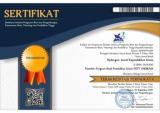Synthesis AuNPs Using Moringa oleifera Extract and Potential Study as Colorimetric Microplastic Detection
Abstract
Keywords
Full Text:
PDFReferences
Afrin, S., & Vickram, A. S. (2025). Crease in optical density reduction of alum treated food waste water and composition with photocatalytic fenton process. AIP Conference Proceedings, 3270(1), 020168.
Ahmad, N., Fozia, Jabeen, M., Haq, Z. U., Ahmad, I., Wahab, A., Islam, Z. U., Ullah, R., Bari, A., & Abdel-Daim, M. M. (2022). Green fabrication of silver nanoparticles using Euphorbia serpens Kunth aqueous extract, their characterization, and investigation of its in vitro antioxidative, antimicrobial, insecticidal, and cytotoxic activities. BioMed Research International, 2022(1), 5562849.
Akintelu, S. A., Yao, B., & Folorunso, A. S. (2021). Green Synthesis, Characterization, and Antibacterial Investigation of Synthesized Gold Nanoparticles (AuNPs) from Garcinia kola Pulp Extract. Plasmonics, 16(1), 157–165. https://doi.org/10.1007/s11468-020-01274-9
Ali, S., Iqbal, M., Naseer, A., Yaseen, M., Bibi, I., Nazir, A., Khan, M. I., Tamam, N., Alwadai, N., Rizwan, M., & Abbas, M. (2021). State of the art of gold (Au) nanoparticles synthesis via green routes and applications: A review. In Environmental Nanotechnology, Monitoring and Management (Vol. 16). Elsevier B.V. https://doi.org/10.1016/j.enmm.2021.100511
Altammar, K. A. (2023). A review on nanoparticles: characteristics, synthesis, applications, and challenges. Frontiers in Microbiology, 14, 1155622.
Aragaw, T. A. (2021). Microplastic pollution in African countries’ water systems: a review on findings, applied methods, characteristics, impacts, and managements. SN Applied Sciences, 3(6), 629.
Bayda, S., Adeel, M., Tuccinardi, T., Cordani, M., & Rizzolio, F. (2019). The history of nanoscience and nanotechnology: from chemical–physical applications to nanomedicine. Molecules, 25(1), 112.
Chen, Q., Zhao, H., Liu, Y., Jin, L., & Peng, R. (2023). Factors affecting the adsorption of heavy metals by microplastics and their toxic effects on fish. Toxics, 11(6), 490.
El-Borady, O. M., Ayat, M. S., Shabrawy, M. A., & Millet, P. (2020). Green synthesis of gold nanoparticles using Parsley leaves extract and their applications as an alternative catalytic, antioxidant, anticancer, and antibacterial agents. Advanced Powder Technology, 31(10), 4390–4400. https://doi.org/10.1016/j.apt.2020.09.017
El-Khawaga, A. M., Zidan, A., & Abd El-Mageed, A. I. A. (2023). Preparation methods of different nanomaterials for various potential applications: A review. Journal of Molecular Structure, 1281, 135148.
Fouda, A., Eid, A. M., Guibal, E., Hamza, M. F., Hassan, S. E. D., Alkhalifah, D. H. M., & El-Hossary, D. (2022). Green Synthesis of Gold Nanoparticles by Aqueous Extract of Zingiber officinale: Characterization and Insight into Antimicrobial, Antioxidant, and In Vitro Cytotoxic Activities. Applied Sciences (Switzerland), 12(24). https://doi.org/10.3390/app122412879
Ganesh, K. N., Zhang, D., Miller, S. J., Rossen, K., Chirik, P. J., Kozlowski, M. C., Zimmerman, J. B., Brooks, B. W., Savage, P. E., & Allen, D. T. (2021). Green chemistry: a framework for a sustainable future. In Environmental Science & Technology (Vol. 55, Issue 13, pp. 8459–8463). ACS Publications.
Garg, R., Dang, S., & Gauba, P. (2025). Molecular Fingerprinting of Heavy Metal-resistant Bacteria through FTIR Analysis Under Heavy Metal Stress. Journal of Pure & Applied Microbiology, 19(1).
Hammami, I., & Alabdallah, N. M. (2021). Gold nanoparticles: Synthesis properties and applications. Journal of King Saud University-Science, 33(7), 101560.
Hong, J., Lee, B., Park, C., & Kim, Y. (2022). A colorimetric detection of polystyrene nanoplastics with gold nanoparticles in the aqueous phase. Science of the Total Environment, 850. https://doi.org/10.1016/j.scitotenv.2022.158058
Janah, I. M., Roto, R., & Siswanta, D. (2022). Effect of Ascorbic Acid Concentration on the Stability of Tartrate-Capped Silver Nanoparticles. Indonesian Journal of Chemistry, 22(3), 857–866. https://doi.org/10.22146/ijc.73196
Kumar, B. N. V., Löschel, L. A., Imhof, H. K., Löder, M. G. J., & Laforsch, C. (2021). Analysis of microplastics of a broad size range in commercially important mussels by combining FTIR and Raman spectroscopy approaches. Environmental Pollution, 269, 116147.
Kumar, I., Mondal, M., Meyappan, V., & Sakthivel, N. (2019). Green one-pot synthesis of gold nanoparticles using Sansevieria roxburghiana leaf extract for the catalytic degradation of toxic organic pollutants. Materials Research Bulletin, 117, 18–27. https://doi.org/10.1016/j.materresbull.2019.04.029
Li, W., Cao, Z., Liu, R., Liu, L., Li, H., Li, X., Chen, Y., Lu, C., & Liu, Y. (2019). AuNPs as an important inorganic nanoparticle applied in drug carrier systems. Artificial Cells, Nanomedicine, and Biotechnology, 47(1), 4222–4233.
Li, X., Yang, B., Xiao, K., Duan, H., Wan, J., & Zhao, H. (2021). Targeted degradation of refractory organic compounds in wastewaters based on molecular imprinting catalysts. In Water Research (Vol. 203). Elsevier Ltd. https://doi.org/10.1016/j.watres.2021.117541
Liu, M., Mu, J., Wang, M., Hu, C., Ji, J., Wen, C., & Zhang, D. (2023). Impacts of polypropylene microplastics on lipid profiles of mouse liver uncovered by lipidomics analysis and Raman spectroscopy. Journal of Hazardous Materials, 458, 131918.
Mikhailova, E. O. (2021). Gold nanoparticles: Biosynthesis and potential of biomedical application. Journal of Functional Biomaterials, 12(4), 70.
Mitomo, H., & Ijiro, K. (2021). Controlled nanostructures fabricated by the self-assembly of gold nanoparticles via simple surface modifications. Bulletin of the Chemical Society of Japan, 94(4), 1300–1310.
Muniyappan, N., Pandeeswaran, M., & Amalraj, A. (2021). Green synthesis of gold nanoparticles using Curcuma pseudomontana isolated curcumin: Its characterization, antimicrobial, antioxidant and anti- inflammatory activities. Environmental Chemistry and Ecotoxicology, 3, 117–124. https://doi.org/10.1016/j.enceco.2021.01.002
Oliveira, A. E. F., Pereira, A. C., Resende, M. A. C., & Ferreira, L. F. (2023). Gold Nanoparticles: A Didactic Step-by-Step of the Synthesis Using the Turkevich Method, Mechanisms, and Characterizations. Analytica, 4(2), 250–263. https://doi.org/10.3390/analytica4020020
Pasieczna-Patkowska, S., Cichy, M., & Flieger, J. (2025). Application of Fourier Transform Infrared (FTIR) Spectroscopy in Characterization of Green Synthesized Nanoparticles. Molecules, 30(3), 684.
Patil, T. P., Vibhute, A. A., Patil, S. L., Dongale, T. D., & Tiwari, A. P. (2023). Green synthesis of gold nanoparticles via Capsicum annum fruit extract: Characterization, antiangiogenic, antioxidant and anti-inflammatory activities. Applied Surface Science Advances, 13. https://doi.org/10.1016/j.apsadv.2023.100372
Perumalsamy, H., Balusamy, S. R., Sukweenadhi, J., Nag, S., MubarakAli, D., El-Agamy Farh, M., Vijay, H., & Rahimi, S. (2024). A comprehensive review on Moringa oleifera nanoparticles: importance of polyphenols in nanoparticle synthesis, nanoparticle efficacy and their applications. Journal of Nanobiotechnology, 22(1), 71.
Poklepovich-Caride, S., Oestreicher, V., Zalduendo, M. M., Bordoni, A. V, Soler-Illia, G. J. A. A., & Angelomé, P. C. (2022). A versatile one-pot room temperature approach for the synthesis of gold nanoparticles with multiple sizes and shapes. Colloids and Surfaces A: Physicochemical and Engineering Aspects, 646, 128890.
Pranata Putri, R., Oktavia Nur Yudiastuti, S., Studi Teknologi Rekayasa Pangan, P., Teknologi Pertanian, J., Negeri Jember, P., & Pranata Putri Program Studi Teknologi Rekayasa Pangan, R. (2024). Green Synthesis dan Karakterisasi Nanopartikel Emas (AuNPs) Menggunakan Asam Askorbat dan Iradiasi Sinar UV. Jurnal Kolaboratif Sains, 7(2), 621–629. https://doi.org/10.56338/jks.v7i2.4717
Sangwan, S., & Seth, R. (2022). Synthesis, characterization and stability of gold nanoparticles (AuNPs) in different buffer systems. Journal of Cluster Science, 1–16.
Shamskhany, A., Li, Z., Patel, P., & Karimpour, S. (2021). Evidence of microplastic size impact on mobility and transport in the marine environment: a review and synthesis of recent research. Frontiers in Marine Science, 8, 760649.
Szczyglewska, P., Feliczak-Guzik, A., & Nowak, I. (2023). Nanotechnology–general aspects: A chemical reduction approach to the synthesis of nanoparticles. Molecules, 28(13), 4932.
Thohir, M. B., Roto, R., & Suherman, S. (2022). A Sol-gel Membrane Utilized Cellulose Paper Doped with α-furil Dioxime for Colorimetric Determination of Nickel. Bulletin of Environmental Contamination and Toxicology, 109(6), 1183–1189. https://doi.org/10.1007/s00128-022-03622-3
Thohir, M. B., & Tiyas, W. P. K. (2024). Colorimetric Sensor of Hg (II) Ion from AgNPs-MO Quantified Using DIC with ED Equation Approach. Hydrogen: Jurnal Kependidikan Kimia, 12(6), 1389–1399.
van de Langerijt, T. M., O’Callaghan, Y. C., Tzima, K., Lucey, A., O’Brien, N. M., O’Mahony, J. A., Rai, D. K., & Crowley, S. V. (2023). The influence of milk with different compositions on the bioavailability of blackberry polyphenols in model sports nutrition beverages. International Journal of Dairy Technology, 76(4), 828–843.
Vijayaram, S., Razafindralambo, H., Sun, Y. Z., Vasantharaj, S., Ghafarifarsani, H., Hoseinifar, S. H., & Raeeszadeh, M. (2024). Applications of Green Synthesized Metal Nanoparticles — a Review. In Biological Trace Element Research (Vol. 202, Issue 1, pp. 360–386). Springer. https://doi.org/10.1007/s12011-023-03645-9
Waragai, A., Nakagawa, T., Hinze, W. L., & Takagai, Y. (2021). Shape-and size-controlled fabrication of gold nano-urchins via use of a mixed sodium borohydride and ascorbic acid reductant system. Langmuir, 37(36), 10702–10707.
Yang, L., Moores, A., Friscic, T., & Provatas, N. (2021). Thermodynamics model for mechanochemical synthesis of gold nanoparticles: Implications for solvent-free nanoparticle production. ACS Applied Nano Materials, 4(2), 1886–1897.
Yazdani, S., Daneshkhah, A., Diwate, A., Patel, H., Smith, J., Reul, O., Cheng, R., Izadian, A., & Hajrasouliha, A. R. (2021). Model for gold nanoparticle synthesis: Effect of pH and reaction time. ACS Omega, 6(26), 16847–16853.
Yuan, Z., & Xu, X.-R. (2023). Surface characteristics and biotoxicity of airborne microplastics. In Comprehensive analytical chemistry (Vol. 100, pp. 117–164). Elsevier.
Zhao, J., Ruan, Y., Zheng, Z., Li, Y., Sohail, M., Hu, F., Ling, J., & Zhang, L. (2023). Gold nanoparticles-anchored peptides enable precise colorimetric estimation of microplastics. IScience, 26(6). https://doi.org/10.1016/j.isci.2023.106823
Zhu, L., Kang, Y., Ma, M., Wu, Z., Zhang, L., Hu, R., Xu, Q., Zhu, J., Gu, X., & An, L. (2024). Tissue accumulation of microplastics and potential health risks in human. Science of the Total Environment, 915, 170004.
DOI: https://doi.org/10.33394/hjkk.v13i3.16603
Refbacks
- There are currently no refbacks.

This work is licensed under a Creative Commons Attribution-ShareAlike 4.0 International License.





